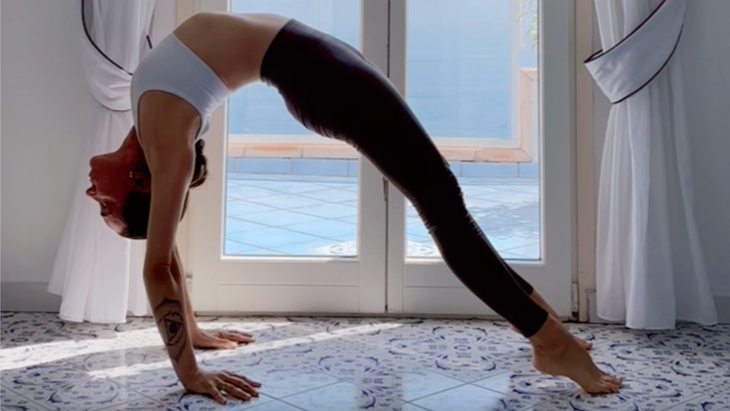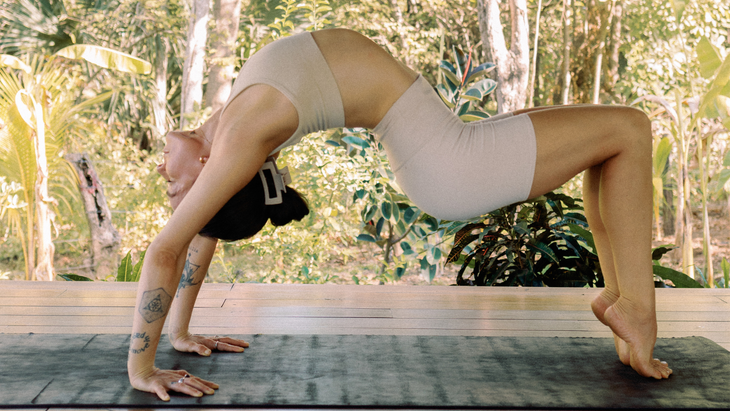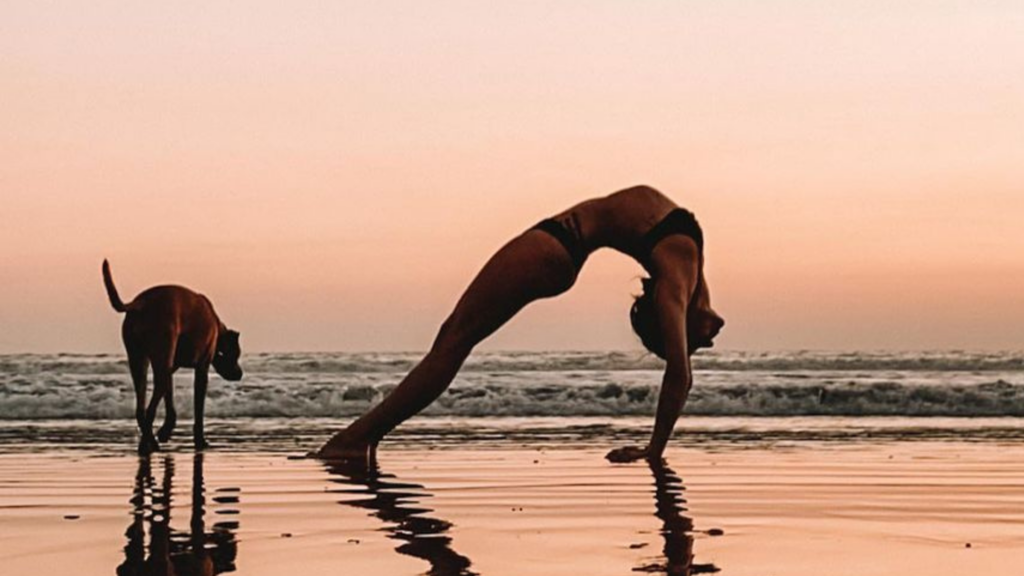“], “filter”: { “nextExceptions”: “img, blockquote, div”, “nextContainsExceptions”: “img, blockquote, a.btn, a.o-button”} }”>
Heading out the door? Read this article on the new Outside+ app available now on iOS devices for members!
>”,”name”:”in-content-cta”,”type”:”link”}}”>Download the app.
Backbends—including Wheel Pose—tend to get a bit of a bad wrap.
“Whenever I tell my students we’ll be working on backbends in class, I usually hear an audible groan, or even a gasp of terror,” says yoga teacher Kayla Nielsen. She believes that some of students’ discomfort comes from sequencing that’s not structured to fully support a backbend or a lack of cues that help students feel strong and grounded enough to explore their flexibility.
Nielsen is accustomed to exploring these issues with students. “Wheel Pose, as well as the variations that come along with it, is a great entry point to advanced backbends,” says Nielsen. From a physical perspective, she explains, students benefit from openness in the chest, shoulders, hip flexors, and quads as well as strength throughout the front and back of the body.
While Wheel and its variations is an inherently strong pose, it comes with a certain softness, too. Nielsen notes that backbends and the opening of the front of the body can spark a primal, protective vulnerability. “The practice of vulnerability is often associated with weakness, the same way backbends are associated with flexibility,” she says. “In my eyes, I see both practices that are actually an embodiment of strength.”
Although it’s among the most intense backbends, it can also be made even more challenging by way of a series of subtle variations that Nielsen teaches.
There’s also strength in patience. “It’s important to remember that Wheel Pose comes at the end of the practice for a reason: it takes almost an entire hour-long sequence to warm up for it!” says Nielsen. Make sure you’ve readied your body before coming into these poses.
Unexpected Wheel Pose Variations
Don’t forget to breathe, which Nielsen points out is a common tendency in intense backbends.
But First, How to (Safely) Come Into Wheel Pose
Start lying on your back as if you’re setting up for Bridge Pose with your feet hip-width distance apart. Inch your heels toward your hips until your fingertips can graze them and keep your knees as wide as your hips. Place your hands flat on the mat alongside your ears with your fingers pointing toward your shoulders and your elbows pointing skyward.
As you’re coming into the pose and throughout, focus on engaging through the legs in order to support the opening that is about to occur. Imagine a block between your thighs (or put one there!) that you hug to keep in place. Scoop your tailbone slightly forward so your low back flattens and your low belly switches on.
Press into your feet and hands so that you lift your body off the mat. Lightly rest the crown of your head on the mat while you look toward the wall behind you..
Exhale here and maintain the activation in your legs so that you feel supported in the low body and light in the upper body, rather than forcing the neck to support your weight. Inhale and once again press deeply into your points of contact with the mat to lift your hips and chest skyward as you continue to breathe.
Start to straighten your arms toward, knowing it’s okay to have a slight bend if you feel tight across your chest. It’s more important to maintain fierce activation in the legs by squeezing the glutes and continuing to hug your imaginary block between your thighs rather than forcing the arms or legs to be straight.

Straight Leg Wheel Pose
In theory, Straight Leg Wheel is straightforward: you’re just in Wheel Pose, but with your legs straight. The reality is straightening your legs will create a lot more sensation along the back of your body as well as across your chest and shoulders. So take it slowly.
How to: Starting in standard Wheel Pose, make sure you’re breathing.
Inhale as you press more firmly into your hands and feet. Imagine that someone’s hands are resting on your front hip points and you’re trying to press your hip points into those hands by squeezing the glutes and doing a slight Cat movement by curling the tailbone forward. This will help relieve tension in the low back.
Exhale as you maintain that engagement and take a small step away from your hands with both feet. Notice how it feels as you continue to drive into the ground with your hands and feet.
Keep breathing as you continue to walk your feet a little farther away from your hands, eventually working your legs toward straight. Tuck your chin slightly. For more sensation in the upper back, chest, and shoulders, gaze between your hands or even back toward your feet.
Notice as you create a wider space between your hands and feet, you’ll initially feel more space in the back body. As you work your legs toward straight, the weight of your chest will create increased sensation across your chest and back body. Make sure you keep your focus on being able to breathe comfortably rather than forcing your legs to be straight.

Straight Leg Wheel Pose With Crossed Ankles
For a subtle shift on the Straight Leg variation, try crossing one ankle over the other.

Alien Pose
Alien Pose is more colloquially known as a Double Backbend due to the curvature of the spine in this Wheel Pose variation. While that’s not entirely true anatomically, there is certainly a lot going on in this shape. Again, take it slowly.
How to: It’s important to enter Alien from Straight Leg Wheel rather than a standard Wheel Pose with your feet closer to your hands. This allows for more space to open across your chest and shoulders
Inhale as you press into the mat through your hands and feet to create activation in the back body and buoyancy in the front body.
Exhale as you maintain all of that activation and imagine you’re sitting your bum into a chair while simultaneously lifting your heels off the mat to make a bit more space in the back body. Keep your shoulders over your wrists rather than allowing them to draw back toward your heels.
Tuck your chin toward your chest if you feel like you need more space in the upper back, chest, and shoulders, or continue to gaze between your hands. For more sensation, look up and back with the eyes as if you’re trying to see your bum.
Continue to breathe. Use inhales as a reminder for activation through foundation and exhales to explore by sinking the hips lower as you reach your chest forward.
Make sure you can breathe in whatever shape you land in, striving to hold the position for 3-5 steady breath cycles.
Continue to explore Wheel Pose and other backbends in Nielsen’s four-week backbend series, Heart-Medicine Backbend.













Leave a Reply